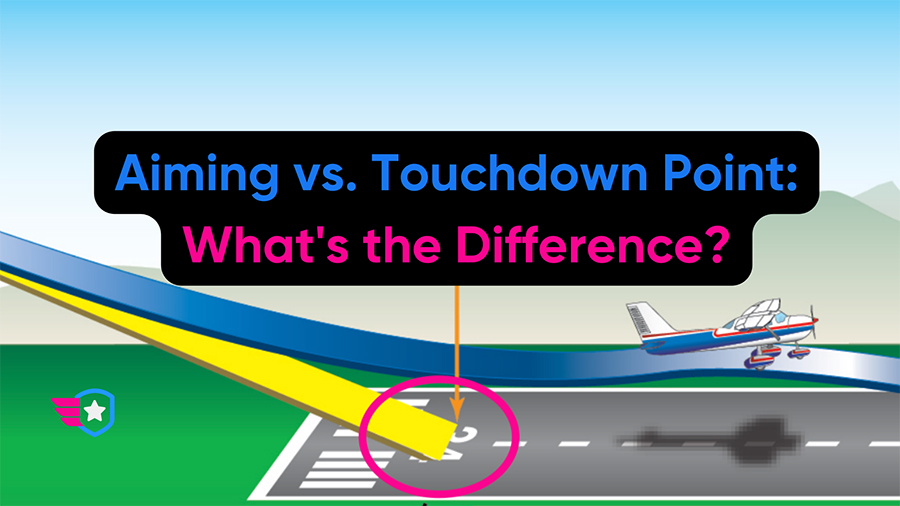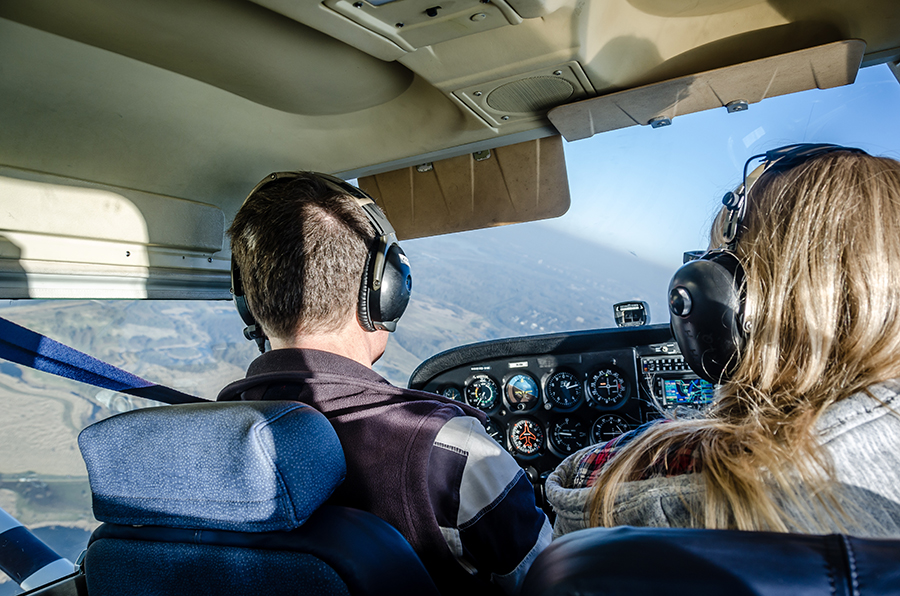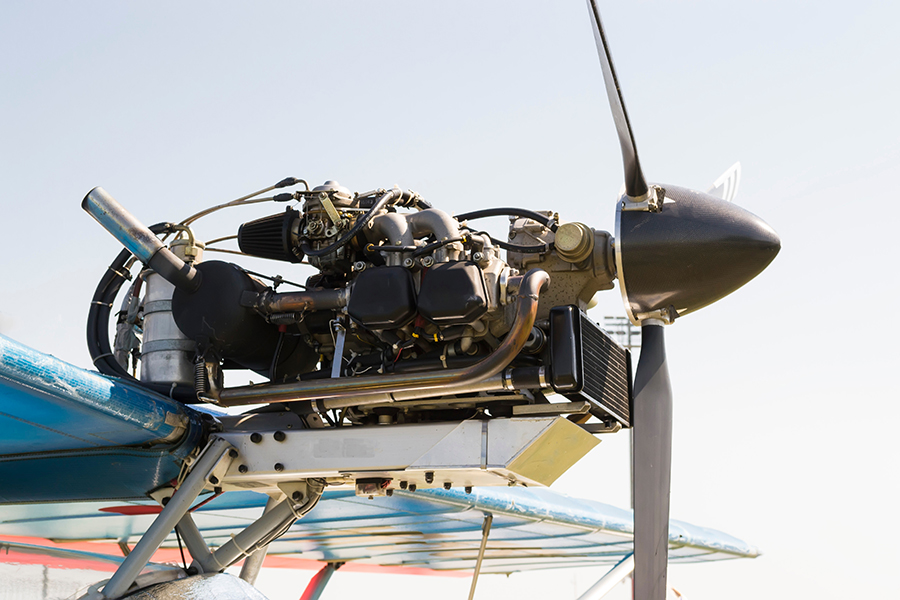-
Key Takeaways
-
Defining Aiming Point and Touchdown Point
- Aiming Point
- Touchdown Point
-
What’s the Difference?
- Distance and Role
- Safety Implications
- Practical Scenarios
- Pilot's Intention
-
Why This Distinction Matters
- Safety
- Operational Efficiency
- Situational Awareness
- Mastery of Landing Techniques
-
How to Use These Points Effectively
- Visual Reference and Scan Pattern
- Adapt to External Factors
- Perfect Your Flare
- Advanced Landing Techniques
- Continuous Training and Feedback
-
Touchdown Point vs. Touchdown Zone
- Definitions
- Purpose and Role
- Visual Indicators
-
Conclusion
Every pilot learns the importance of visual cues during landing, but a common pitfall remains: misunderstanding the aiming point and touchdown point.
These terms, while closely related, serve distinctly different roles during landing.
Confusion around the aiming and touchdown points can significantly affect safety and landing efficiency. Let’s make sure that doesn’t happen to you.
Dive in with us as we unravel the differences between the aiming and touchdown points, and ensure you nail your landings every time.
Key Takeaways
- The aiming point is the spot on the runway that pilots target during the final approach, providing a guide for the correct glide path.
- The touchdown point is the exact location where the aircraft’s wheels touch the runway during landing.
- The touchdown zone is a broader area of the runway where landing is intended, whereas the “touchdown point” is a specific spot within that zone.
- The aiming point is marked by large white rectangles.
- The touchdown zone has multiple striped rectangular markings.
Defining Aiming Point and Touchdown Point
While the terms “aiming point” and “touchdown point” both play pivotal roles in the landing phase, they’re not interchangeable.
Let’s delve into these two terms, define their significance, and understand why it’s crucial to distinguish between them.
Aiming Point
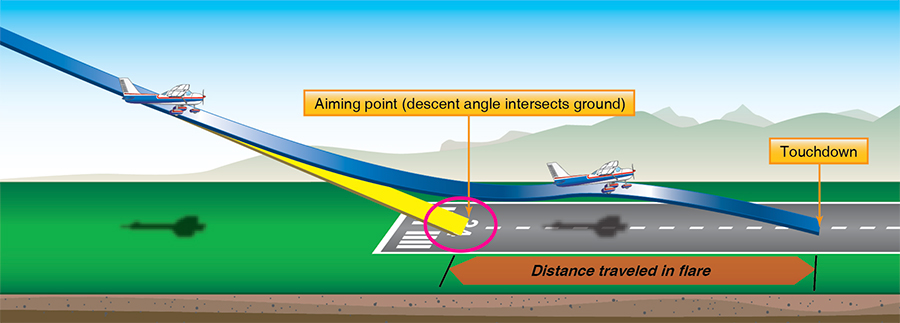
The aiming point is the designated spot on the runway where pilots set their sights during the final approach. It acts as a visual guide to help maintain the correct glideslope for landing.
Aiming for this point ensures that the aircraft maintains a stable approach, reducing the likelihood of undershooting or overshooting the runway.
On most paved runways, the aiming point is marked by large white rectangles, often referred to as touchdown zone markings. These are usually located roughly 1,000 feet from the runway’s beginning, providing a consistent visual cue for pilots.
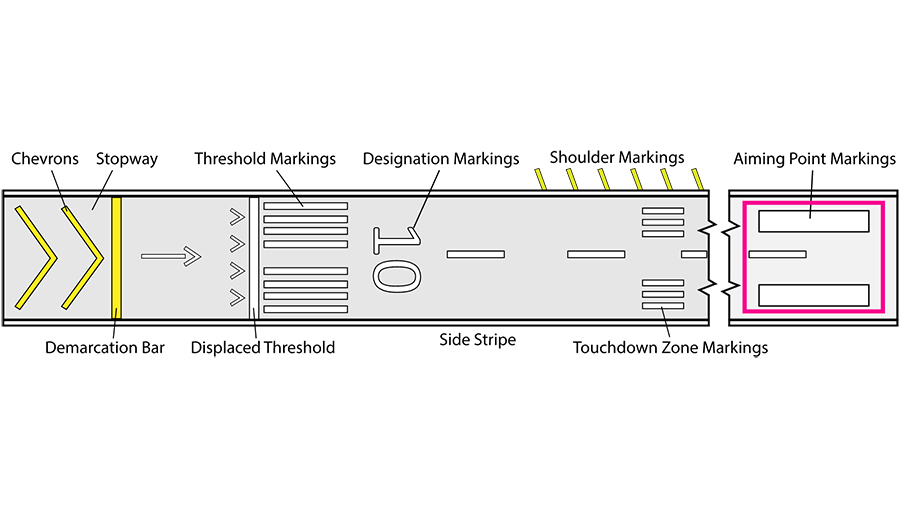
Touchdown Point
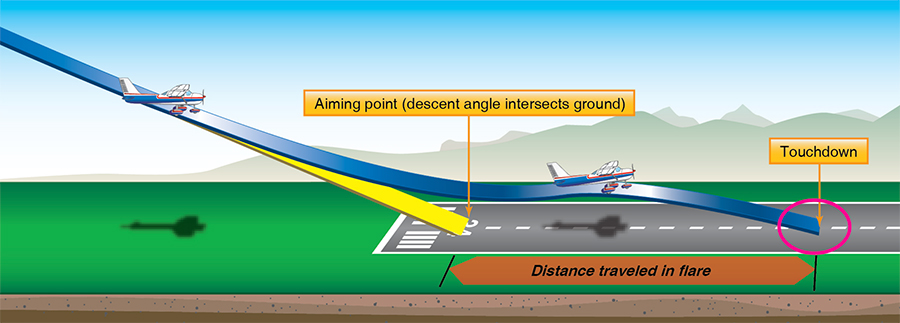
The touchdown point is the specific location where the aircraft’s wheels first make contact with the runway during landing. It’s the culmination of the aircraft’s final approach and signifies the start of the ground roll phase.
Recognizing the intended touchdown point is crucial for safety. Landing too soon or too far into the runway can lead to runway overruns or other complications, especially on shorter runways or during adverse conditions.
Several variables can affect where an aircraft touches down, including prevailing wind conditions, the aircraft’s weight on that particular flight, the chosen approach speed, and the pilot’s technique and experience.
Because the touchdown point is variable, runway markings contain a “touchdown zone” where it is safe to touch down (we’ll explain the differences between the touchdown zone and touchdown point later).
The touchdown zone contains multiple thin white stripes as markers, indicating the remaining runway available.

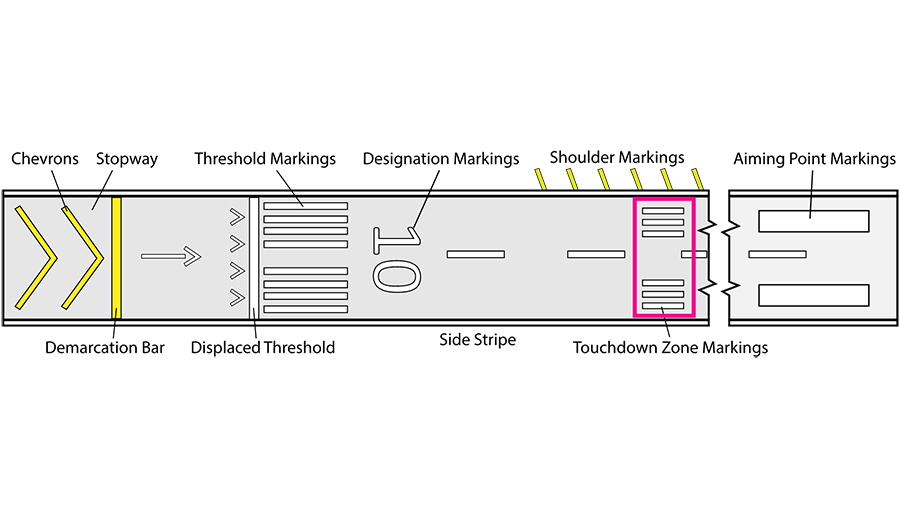
What’s the Difference?
The distinction between the aiming point and the touchdown point may seem nuanced, but understanding the difference is essential for a safe landing.
Distance and Role
Think of the aiming point as your visual target during the approach. It’s the point you align your aircraft with to ensure a stable descent.
If you are on a perfect final approach, the aiming point is the point you would hit the runway if you didn’t flare.
But it’s not necessarily where you intend to land. Instead, it serves as a guidance tool to help you maintain the correct glideslope and descent rate.
The touchdown point, on the other hand, is the culmination of your approach – the exact spot where the aircraft’s wheels touch the runway. It’s influenced by the aiming point, but it’s further down the runway due to the aircraft’s flare and float during the final moments of landing.
Safety Implications
Keeping a consistent aiming point ensures that you don’t undershoot the runway or come in too steep, both of which can lead to dangerous situations.
When it comes to the touchdown point, properly judging where the aircraft touches down means you’re allowing ample runway for the aircraft to decelerate and come to a complete stop. Misjudging this can risk a runway overrun.
Practical Scenarios
In a strong headwind, for example, your aiming point remains the same, but you might find that your touchdown point shifts closer to the aiming point due to the decreased ground speed.
Conversely, with a tailwind, even if aiming for the usual aiming point, the aircraft may float longer during landing, pushing the touchdown point further down the runway.
Pilot’s Intention
The aiming point remains consistent and is used to maintain the correct flight path.
The touchdown point can vary based on conditions and pilot decisions. For example, in a short-field landing, a pilot might intentionally aim for an earlier touchdown to ensure maximum runway for deceleration.
Why This Distinction Matters
Safety
The aiming point ensures the correct glideslope and the touchdown point ensures that you have enough runway to come to a stop – both critical aspects of a safe approach and landing.
Operational Efficiency
By differentiating between the two points, pilots can better manage their aircraft’s energy, ensuring smoother and more controlled landings.
This distinction is crucial, especially when dealing with variable conditions such as crosswinds or wet runways.
Situational Awareness
Recognizing the difference enables pilots to adapt to real-time scenarios, like making decisions about go-arounds.
If a pilot recognizes deviation from the aiming point or touchdown zone, understanding this distinction allows them to take appropriate action.
Mastery of Landing Techniques
There are several advanced landing techniques, like short-field or soft-field landings, where the differentiation becomes even more critical.
For example, in a short-field landing, understanding and controlling the exact touchdown point is paramount to ensure there’s ample runway left to stop the aircraft.
How to Use These Points Effectively
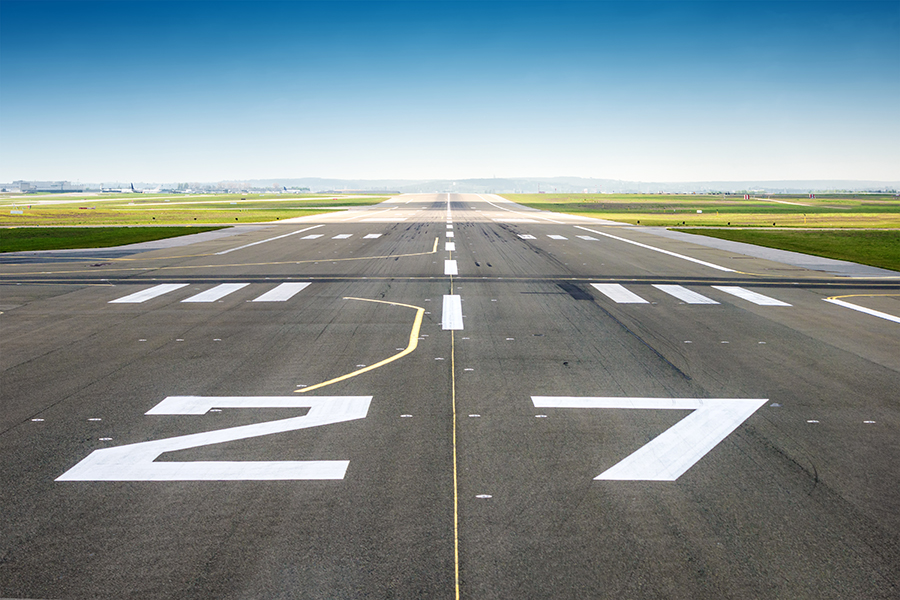
Harnessing the power of the aiming point and touchdown point requires more than just understanding their definitions.
Here’s how to make the most of these crucial landing references.
Visual Reference and Scan Pattern
If the runway does not feature a dedicated aiming point (two solid white stripes), choose a specific mark on the runway as your aiming point, such as the runway numbers.
Adjust your visual reference beyond the aiming point during the flare to anticipate where your aircraft will touch the ground. Looking at the end of the runway during the flare provides better situational awareness.
Adapt to External Factors
Wind speed and direction can influence where you touch down. In strong headwinds, your touchdown point may be closer to your aiming point, while tailwinds might push it further down the runway.
While the landing roll calculations should be performed before the approach, ensure you touch down within the touchdown zone to ensure that the numbers remain valid.
If you touch down after the touchdown zone, your calculated runway length is invalid and may lead to a runway overrun.
Perfect Your Flare
The flare, that final pitch-up before touching down, is where the transition from aiming point to touchdown point occurs.
Practicing your flare helps you control where and how smoothly you land.
Advanced Landing Techniques
For specialized landings, like soft-field or short-field approaches, emphasize control over your touchdown point.
This might mean adjusting your aiming point or approach path to achieve the desired outcome.
For example, during a normal approach, you would use the standard aiming point markings on the runway. During a short field landing, you may want to use the runway numbers as your aiming point to ensure that you touch down sooner.
Continuous Training and Feedback
Regularly practice various scenarios, from crosswind landings to challenging runway conditions.
Use tools like flight simulators or get feedback from more experienced pilots to improve your skills in using the aiming and touchdown points.
Touchdown Point vs. Touchdown Zone
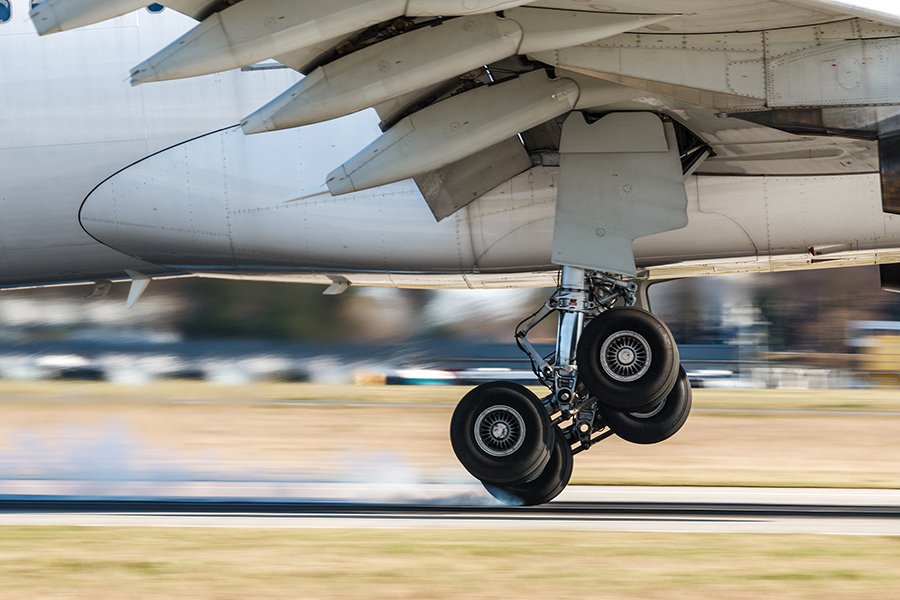
Definitions
The touchdown point is the specific point on the runway where the aircraft’s wheels first make contact. It’s a precise location influenced by various factors like aircraft speed, weight, and external conditions.
The touchdown zone is a broader area of the runway, typically marked with specific rectangular markings, where an aircraft should touch down.
In the context of commercial airports and larger runways, this zone spans the first 3,000 feet from the threshold.
Purpose and Role
Understanding and aiming for a specific touchdown point allows pilots to exercise precision in their landings, ensuring that they make contact with the runway where intended.
The touchdown zone serves as a target region for pilots. When landing, especially in larger aircraft, pilots aim to have their wheels down within this zone to ensure there’s sufficient runway length left for a safe stop.
Visual Indicators
Often, there may not be a physical marker for the touchdown point. Instead, it’s determined by the pilot’s approach and where the aircraft ends up touching down.
The touchdown zone is recognizable by its distinct rectangular markings on the runway. These markings guide pilots, offering a visual reference to ensure they’re landing within the desired area.
Most runways without a published instrument approach do not feature touchdown zone markings. The majority of runways do feature aiming point markings, however.
Conclusion
Now that you have a solid understanding of the aiming point and touchdown point (and why they’re important), check out our Essential Guide to Runway Markings to learn about other symbols you may find on a runway.
